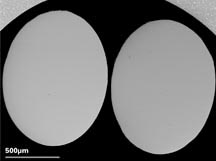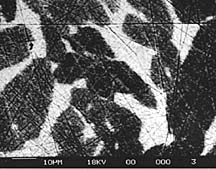
Electron micrograph of the
nickel/copper backscattered
electron reference specimen.
BSE image at low magnification.
The contrast difference between
the two wires is visible due to
the
atomic number difference
between
the nickel/copper. |
BSE Atomic Reference Specimen
An electron microscope, when equipped with a backscattered electron detector, has the capability to produce images in which the contrast is controlled by differences in atomic number (Z) across the specimen. Four reference specimens are now available that are suitable for testing the atomic number contrast performance of a backscattered electron detection system.
Each of the reference specimens consists of two high purity elements that have an atomic number difference of 1. They are in the form of two wires embedded side by side in a contrasting matrix.
The specimens are available as a single mount either 3mm or 5mm diameter brass or aluminium tubes or alternatively can be incorporated into a block of standards.
|
| Prod #
| Description
| Unit
| Price
| Order / Quote
|
| 652
| BSE Atomic Reference, Nickel (Z-28) - Copper (Z-29)
| each
| $1098.70
|
|
| 653
| BSE Atomic Reference, Palladium (Z-46) - Silver (Z-47)
| each
| 1085.50
|
|
| 654
| BSE Atomic Reference, Platinum (Z-78) - Gold (Z-79)
| each
| 1071.80
|
|
|
 |
Duplex Reference Specimen
An alternative and very sensitive test is by means of an alloy with two major copper/zinc phases
separated by an atomic number difference of 0.1. The light phase illustrated in the micrograph has
a mean atomic number of 29.47 and the dark phase a mean atomic number of 29.37. |
| Prod #
| Description
| Unit
| Price
| Order / Quote
|
| 655
| Duplex Reference Specimen
| each
| $1095.70
|
|
|